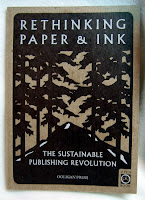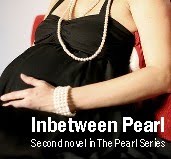 The Pearl of Carol blog is giving away two copies of a mini-book, RETHINKING PAPER & INK regarding sustainability in publishing to celebrate the recent Write to Publish Conference sponsored by Ooligan Press. Mention ‘enter to win’ in your comments to participate. Drawing to be held at end of month.
The Pearl of Carol blog is giving away two copies of a mini-book, RETHINKING PAPER & INK regarding sustainability in publishing to celebrate the recent Write to Publish Conference sponsored by Ooligan Press. Mention ‘enter to win’ in your comments to participate. Drawing to be held at end of month. Part Two: Authors abandoned from the big houses use their savvy to generate the small press movement, wholesalers and distributors keep small press—literary non-fiction on the shelves, the influence of the mega-booksellers and Amazon.
How do new authors break in?
Besides inspired writing, what do new authors need to break into publishing? “Five years ago I would have said you need $200,000 and eat very little for the first five years to afford the cost of returns, in fact, keep your day job,” recommended Dennis Stovall, professor of English and Coordinator of Publishing Curriculum at Portland State University. Stovall opened the recent Write to Publish Conference with a talk on the state of the publishing industry. Today he adds, “Create a kind of word of mouth, viral marketing that reaches more people than traditional media or book store browsing.” Many are finding Facebook fans, swooping in for Twitter followers, and connecting with LinkedIN to begin their outreach to a potential fan base. [The First Carol on Twitter].
Despite these social media opportunities, bookstores remain the best distribution outlet. Established authors dominate the chains, and it’s hard to find anyone willing to open small shops unless they are far away from the mega-sellers. Add to that the current lag in the economy which has roughed up the remaining marketplace as sellers jostle for share, and you have all bad news. Right? Not necessarily. “Eating each other up leaves opportunity,” comments Stovall, and opportunity, he suggests, may lie in places other than paper and ink. “Forty percent of every print run goes into recycle—that’s the average. That doesn’t happen with digital books.”
Sales and reading
Dennis Stovall challenged assumptions we’ve been making over the last twenty about reading. “The National Endowment of the Arts did two major surveys concluding reading is at risk. You read that and you became demoralized. It appeared all we were reading were cookbooks and weight loss books. It’s been nothing like that.” he said, and stressed the studies ignored a critical aspect of reading, namely all the new ways the new generation is reading, and it’s not always the traditional canon of literature. “I have particular interest in what constitutes writing as art and writing as commerce. It’s shifting so fast. I see it in the papers that I grade, an enormous shift. You don’t go back you only go forward.” But go forward into what? “Where does the potential lie?” Stovall asked, then answered, “We don’t KNOW what is going to happen next. It (publishing) can be invented again now, not only in this country but world-wide. It is being reinvented and reinvented quickly.
“Non-fiction continues to sell better than anything else. The average life of a book sells 5,000 copies, non-fiction 7,500, poetry under a 1,000. Performance poetry, revival of an oral tradition is finding its way into print,” Stovall noted. “Something very few of us thought we’d see happen. Now that audience becomes potentially much larger than it ever was before.” To grow any audience it must be nurtured.
Opportunities to develop audience abound for those willing to speak and to teach with the realization they do not generate enormous sales, but rather incremental gains in audience. “Lose the gleam in your eye that says, ‘I’m going to sell a million books.’ The realistic view is that if you pursue correctly you may not be able to make a great living, but you may be able to develop a body of work that won’t go out of print in a digital world."
Stovall weighed in on the industry’s struggle with the pricing structure. “How do we price in this new model?” he asked. The marketplace is still deciding how much it will pay for a digital book.” Other sources indicate readers believe there is great savings when a book does not consume paper and ink, and they want that savings passed along not pocketed. But pricing the POD less than a printed book may not be the answer.
Mass vs. made-to-order printing
The print-on-demand machine looks like a large refrigerator, punch up the book you want, put in your credit card, and in 3-5 minutes you can hold a printed book completely bound with cover in your hands. It’s the ATM of books, making them more accessible, reviving books that are abandoned, no longer in print, or only available on library shelves. It can instantly put books where you want them when you want them, for example, an Espresso Book Machine at the trail head of a National Park spewing books on flora and fauna. You’re not likely to reach for that book anywhere else, but in that moment it has great value.
What are the advantages of breaking in with print on demand - one book at a time publishing? Digital short run printing is accomplished with liquid toners rather than powder and is rather economically produced. “We are a capitalist society, as the costs come down with new technology we’ll have a slightly more economic entry point.”
The Espresso Book Machine’s $100,000 price tag limits its mainstream access, but it is making inroads. Pocket Books who mass markets Paperbooks, is now promoting the Espresso Book Machine (EBM). Lightning Source Inc., an Ingram Content company announced EBM as a distribution channel to all publishers that work with the company. Stovall sees tremendous democracy in these actions, but admits machine owners still dictate content. “You’re going to see mix and match opportunities, enormous opportunities for both writers and publishers, but the problem for writers is they have taken the notion of self-publishing too far.”
Authors can’t do it all
All aspects of publishing cannot be tackled by a writer. “Editing it yourself is a mistake.” If you’re not a book designer you can’t know what others have studied earnestly to comprehend—visuals that sell. “Less than stellar projects do not create audiences, they get ignored, are not cataloged and are not bought,” Stovall said. In reality almost nothing is ready to go to press at the beginning. Writers need to remember their book is not done simply because they’ve completed their massive draft. “But books are being produced that have not been vetted in any way, and yet the more demanding the marketplace, the more it requires professionals.”
Literary Agencies along with publishers are another necessary mediator, “But if there is push for profit agencies may be driven out. We’ll see agents with a shifted role,” Stovall predicted, then lamented the lack of agent input, “Lulu has published the largest pool of bad poetry in the world.” He also noted a common query: grandparents with stories they told their kids. “Mushy stuff we should have kept to ourselves.”
Over and over again publishers read queries not appropriate to the press. “The onus is on the author to pay attention to what the press publishes and create a strong proposal.” Stovall advised. “Even a rough cut gem will get a serious reading, but direct yourself to the right publisher.”
To locate the correct publishing partner you need to first define your audience. Stovall offered several suggestions including, “Locate a magazine you know is read by the same people who would be interested in your book, and ask the magazine for their media kit, or look for their media kit online. It tells you the demographic of their audience and you now have the audience for your book.” He further added, “Go to Powell’s, imagine what shelf your book might be on, look at the shelf and check out the publishers.” A little research on those publishers can confirm whether they should be targeted. “Bet on that as an author and then you’ll get a hearing,” Stovall promised.
His final admonition critical to success. “When asked who would read your book, the worst thing you can say, ‘Anyone who likes a good read.’ You have to know who would read your book. You HAVE to know.”



































![Validate my RSS feed [Valid RSS]](https://blogger.googleusercontent.com/img/b/R29vZ2xl/AVvXsEiAIPReZorWncm8rqb2sSJRToPKpOGvLVLIgPtfxjxu0dWp8vAiyz8tbz8M34zpnRUMU7gt-vjPvEGsTfn5AfL4_KnzLj0up6PTs7yQWt_ClPyj8oYhoVbhZdWtah0mX6VY_6S5GRembsg/)